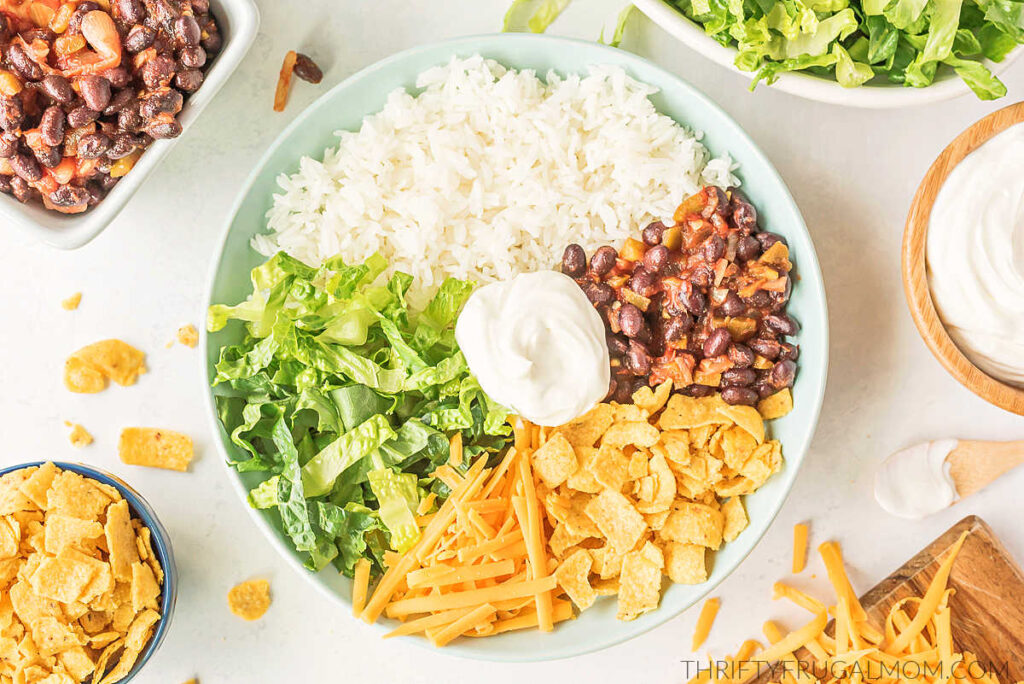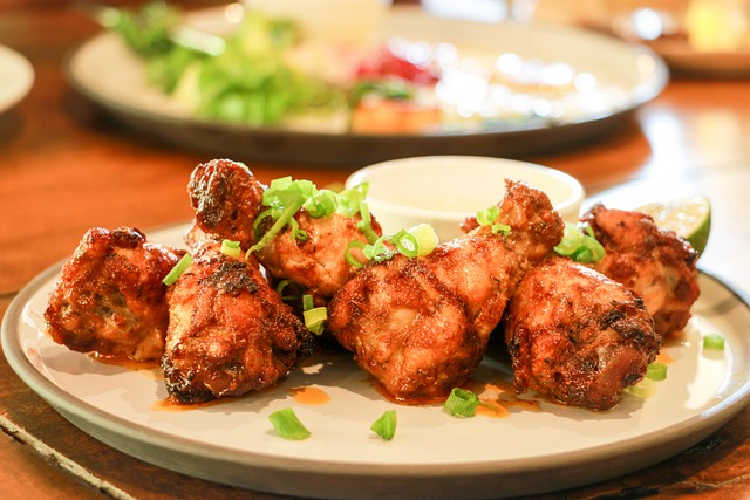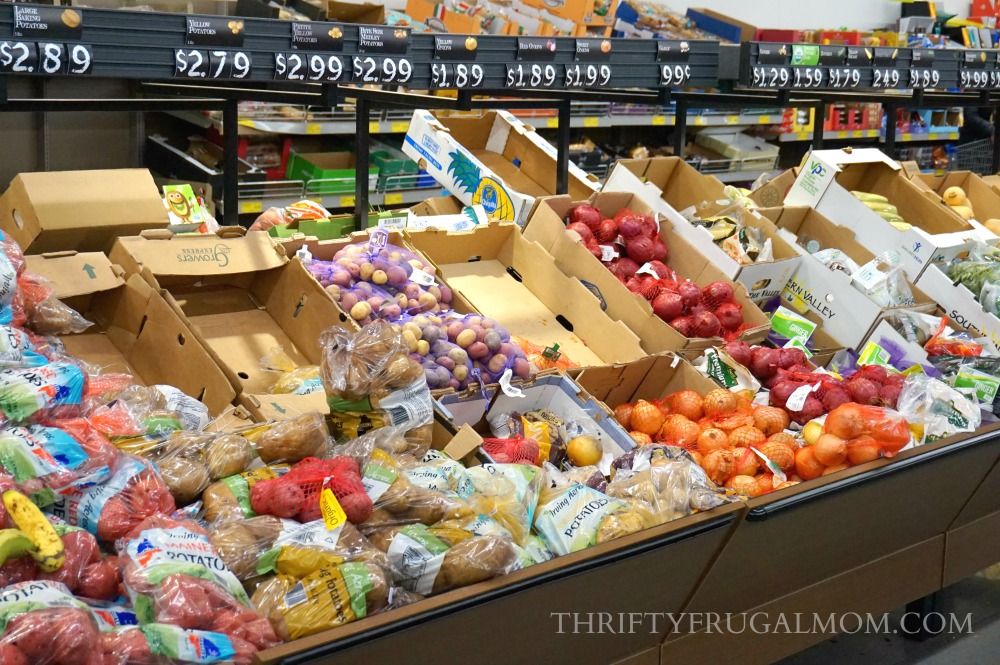Eating healthy on a budget really is possible! These easy tips will help you learn how to save money while eating healthier. Lots of great ideas that are perfect for everyone!
There are affiliate links in this post – please read my full disclosure policy. As an Amazon Associate, I earn from qualifying purchases.
It can feel like eating healthy is just so expensive! But the truth is, there are lots of things you can do to help make your money go further while making healthier food choices.
I’m definitely not a health expert, but I do love to learn about nutrition and health. And over the 15 years that I’ve been responsible for feeding my family, I’ve gradually made changes that have allowed us to eat healthier while still sticking to a low grocery budget.
If you are looking for simple ideas that are doable for the average person, this list is for you!
Learn How to Eat Healthy on a Budget
1. Eat More Beans and Legumes
Lentils, beans and chickpeas are packed with protein and fiber and are much cheaper than meat.
I love adding them to salads. And if I am making a Mexican-inspired recipe, I almost always swap out some of the meat for black beans instead.
Here are a few easy, delicious bean recipes:
2. Be Smart About “Expired” Food
Pretty much all food is still safe to consume after the expiration date. In fact, if you take a look at the wording on a package, many times it will say “Sell By Date” or “Best By Date”.
This simply means that the food should be sold by that date but that it still will be okay to consume for at least several more days.
Or it can simply mean that the manufacturer does not guarantee that the quality of the food will be 100% after that date. For example, the texture may change slightly or it may lose a bit of flavor.
Being less quick to throw out food that is past the expiration date can save lots of money and help avoid food waste!
Read more: Food Expiration Dates…What to Know
3. Choose Healthy Snacks
Not only is a bag of potato chips expensive, but they also are not very nutritious!
Choosing healthier snack options such as a piece of fruit, veggies and hummus, sunflower seeds, nuts, a piece of dark chocolate or cheese and crackers will allow you to give in to that snacking urge while also nourishing your body.
Related: 30 Cheap Healthy Snack Ideas for Kids and Adults
4. Choose Low Sodium Options
According to the Centers for Disease Control, about 90% of Americans consume too much sodium!
One simple way to combat this is by looking for low-sodium choices in things like canned beans, canned soups and canned vegetables.
5. Avoid Pre-Cut Produce
While convenient, diced onions, shredded cabbage and cubed watermelon cost at least three to four times as much buying whole onions, a head of cabbage or half a watermelon.
Taking a few minutes to prep these foods yourself can save you a lot of money!
6. Avoid Processed Foods
Not only are processed foods typically full of preservatives and other unhealthy ingredients, but they are also often loaded with sodium too.
Eliminate processed foods where possible or make your own convenience foods from scratch! You’ll be surprised at how quick and easy many of them are to make yourself!
7. Make Your Own Yogurt
Homemade yogurt is ridiculously easy to make and will save you a lot of money! Here are two recipes to try: Super Easy Homemade Yogurt (made using your oven) and Instant Pot Yogurt.
8. Buy Generics
Generic brands can be a great way to save and often they taste just as good as the name brand, sometimes even better!
9. Skip the Bagged Lettuce and Salads
Buying lettuce by the head is much cheaper than buying it pre-chopped and bagged. Along the same lines, pre-made salads are not only more expensive, but they also typically aren’t as fresh and spoil more quickly as well
10. Make Your Own Granola
Homemade granola is super easy to make and cheaper than buying storebought. This Basic Homemade Granola and this Super Easy Chocolate Granola are our favorites.
11. Cook Once, Eat Twice
When you are making a recipe, double it and then use the extra for another meal later in the week.
This not only saves time but it also can help save you money by reducing the chance of you feeling like you need to grab takeout.
Bonus Money Saving Tip!
- Sign up for Fetch to save more on your shopping trips. You get rewarded simply for snapping a photo of your receipt! Plus, they regularly have offers to save on all sorts of grocery items too.
12. Grow Your Own Vegetables
Growing your own vegetables isn’t always cheaper, but if you buy mostly organic produce it often is, especially if you are strategic with what you plant.
Things like tomatoes, onions, lettuce, squash and peppers can be fairly easy to grow inexpensively and most don’t take a lot of space either. In fact, you can even grow tomatoes and peppers in pots on a balcony or deck!
13. Use Eggs as a Cheap Protein
Eggs are a great source of protein and are definitely more than just breakfast food!
Hard-boiled eggs make a great snack or lunch and are delicious in salads. Egg salad is easy to make and quite tasty. And Shakshuka is a simple, delicious dinner.
14. Meal Plan
Planning out your meals is one of the best ways to eat healthy on a budget.
Figuring out what you will eat ahead of time lowers your chance of resorting to grabbing takeout and it also allows you to think through creating more balanced meals.
Not sure where to start with meal planning? $5 Meal Plans is a great option.
You can also get my FREE $50 Aldi Meal Plan here!
15. Make Your Own Coffee Drinks
Coffeeshop iced coffees, lattes and frappuccinos are pricey and they also are usually loaded with sugar too.
Making your own drinks at home will save you lots of money. Plus, you can control the ingredients and do things like use skim milk, sweeten it with stevia or just use less sugar, making it healthier too.
Easy homemade coffee drink recipes:
16. Know What You Have
Being organized with your fridge, freezer and pantry helps to reduce food waste because you’ll have less food spoil.
It also means that making meals at home will be easier because you’ll be more likely to have the ingredients on hand for the recipes you want to make.
17. Make Your Own Chicken Stock
Chicken stock, or bone broth, is highly nutritious and super easy to make.
Any time you buy a whole chicken or turkey, you can use the bones to make broth that you can either drink by itself or use in soups…and it will cost you just pennies!
18. Use Canned Salmon and Tuna
Canned fish is much cheaper than fresh and has the same nutritional value.
19. Make Your Own Oatmeal Packets
Making your own instant oatmeal packets is super easy and will save you loads of money!
20. Eat More Chicken
Not only does chicken have less saturated fat than red meats, but it also is generally less expensive as well. Adding more chicken recipes to your menu is a simple way to help lower your budget while also eating healthier.
Here are a few of my favorite chicken recipes:
21. Shop at Thrive Market
Thrive Market is a membership-based online store that offers natural and organic foods.
If you don’t have specialty grocery stores nearby and you buy a lot of specific healthy snacks and pre-packaged sauces and canned good etc. then Thrive Market can be a great way to save!
Save 40% off your first order here plus get a free gift!
22. Eat More Meatless Meals
Not only is meat often one of the biggest grocery expenses, but research also has shown that consuming too much is not good for our health.
Switching to more meatless, vegetarian meals can be a simple way to save money and eat healthier!
Need recipe ideas? Here are 30 Easy Meatless Meals that are cheap and quick.
23. Drink More Water
Drinks of any kind are expensive and most aren’t that good for you either. Stick with water and you’ll not only save money but you’ll be healthier too!
24. Eat More Whole Grains
Whole grains are good for your heart and are also are a good source of fiber that helps you feel full more quickly.
Swap regular pasta for whole-grain pasta. Buy whole-grain bread instead of white, brown rice instead of white rice and rolled oats instead of quick oats.
25. View Meat as a Side
When you plan your menus, focus on smaller portions of meat and larger portions of legumes, vegetables, potatoes etc.
26. Use Your Freezer
Save money by taking advantage of foods when they are on sale, then freeze them to use in the future. Reduce food waste by freezing leftovers, fruits and vegetables, bread, cakes and more!
Related: 40 Foods You Can Freeze to Save Money– I think you’ll be surprised at some of the items listed!
27. Buy In-Season Produce
Not only does produce that is harvested at the peak of freshness taste better, but it’s also usually cheaper too as it’s more plentiful and doesn’t need to be shipped as far.
28. Choose Less Expensive Cuts of Meat
Sticking with cheaper cuts of meat can save a lot! Chuck roasts can be made very tender when cooked in a slow cooker.
Ground beef is going to always be cheaper than cubed beef. Bone-in chicken costs less than boneless. When possible and where it makes sense, use the less expensive cut.
29. Swap the Soda
Kefir and kombucha are great fizzy alternatives to soda and both are full of good probiotics too! And if you make them yourself they’re quite inexpensive as well.
We love water kefir and this tutorial makes it easy to get started making it!
30. Buy in Bulk
Buying in bulk isn’t always cheaper, but it’s definitely worth looking into. Two of the items that I often buy in bulk are oatmeal and rice.
31. Use More Frozen Produce
A 2017 study found that frozen produce has just as much nutritional value as fresh produce. In fact, in some instances, it is actually more nutritious!
Frozen produce is also typically cheaper and results in less food waste. So it definitely makes sense to use frozen when possible.
32. Grow Your Own Herbs
If you frequently cook with fresh herbs, it’s worth growing your own. The easiest way to get started is to simply grab a plant from the produce section at your local grocery store. You can keep it in a sunny spot in your house or if you prefer, plant it in your garden.
These helpful indoor herb growing tips will make it easy to be successful!
33. Creatively Use Up Food
Reduce the amount of food you throw away by finding ways to use leftovers in soups, salads, stirfries and more.
You can also find creative ways to use foods that you’d typically throw away too, such as stale bread, sour milk, brewed coffee, dried-out cheese and more.
34. Buy Marked Down Foods
Make it a habit to visit the marked-down food area of your grocery store. Readjust your meals to work in these items that quickly need to be used or lengthen their life by freezing them.
35. Substitute Ingredients
Learn to swap out ingredients for less expensive options or healthier options. For example, plain Greek yogurt can be substituted for sour cream. In cooked recipes, spinach and kale can usually be swapped.
If you want more ideas, check out this list of 18 Simple Ingredient Substitutions.
36. Stick with Inexpensive Fruits and Vegetables
Carrots, potatoes, cabbage, squashes, bananas and apples are some of the cheapest produce options, while things like berries and cauliflower tend to always be on the pricier end of things.
Focusing on the cheaper options and watching for sales can save a lot!
37. Choose Organic Wisely
If you prefer to buy organic, use the Dirty Dozen and Clean 15 lists as guides for which fruits and vegetables are worth paying more for.
Also, if you shop at farmer’s markets and buy from small, local sellers, it’s wise to ask them about their growing practices. They often are growing organic produce, but just aren’t big enough to go through the process of becoming certified.
38. Watch the Unit Price
Taking a moment to scan an item’s shelf price tag can quickly show you the price per ounce or another unit of measurement. Use this to easily compare prices between package sizes and brands and make sure you are getting the best bargain!
39. Pack Your Own Lunch
I know a packed lunch isn’t as much fun, but it sure can save you money. If you spend just $7 on lunch three days a week, in one year you are spending over $1,000 just on those lunches!
Packing your own lunch also can allow you to choose healthier options as most pre-made, take-out food is high in sodium and unhealthy fats.
40. Shop at Aldi
I am a huge fan of Aldi! They have all the basic grocery items but at much cheaper prices. And the quality of their food is really good too!
If you buy a lot of organic, you’ll be happy to know that they also have a nice selection of organic foods.
Other articles you’ll enjoy:











Lisa
Thanks for this. Providing URL for a non-profit group of youth, so I don’t have to write up a similar article. ;D We think very much alike.
Lydia Beiler
You are welcome, Lisa! And thanks for sharing.
Carola Jain
This piece definitely goes a long way in showing that eating on a budget doesn’t necessarily have to be impossible. It’s just a matter of making the smartest choices. Great write-up here!
Lydia Beiler
Thank you, Carola!